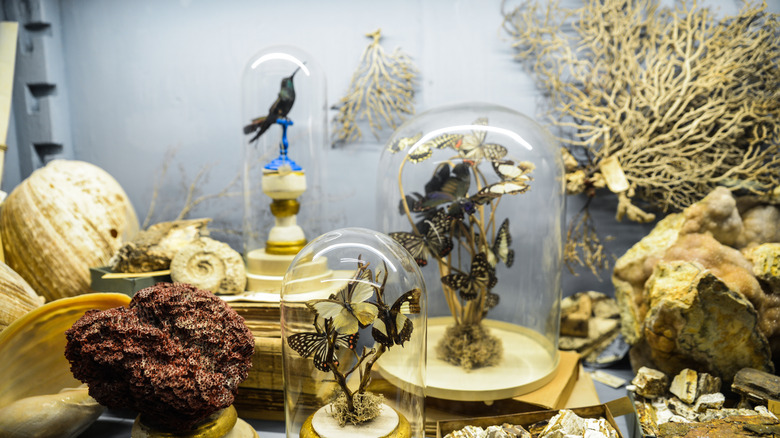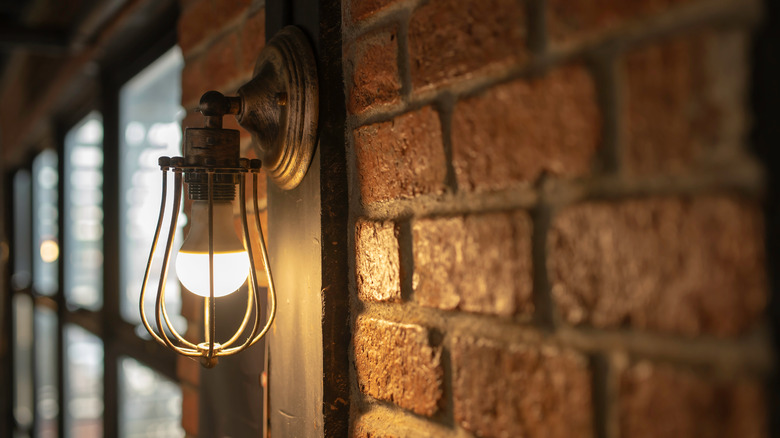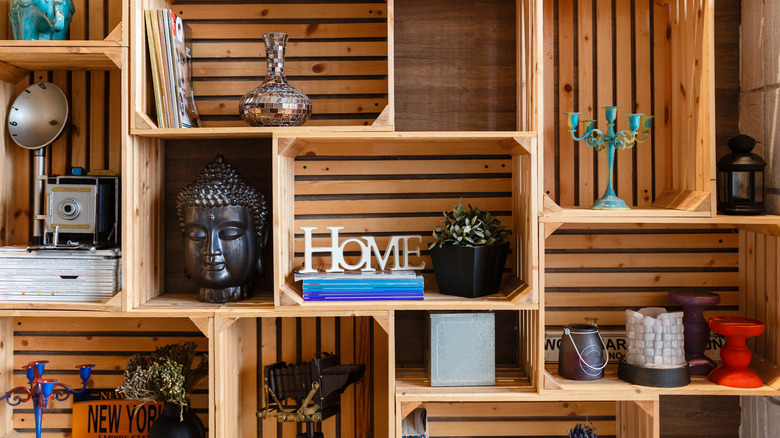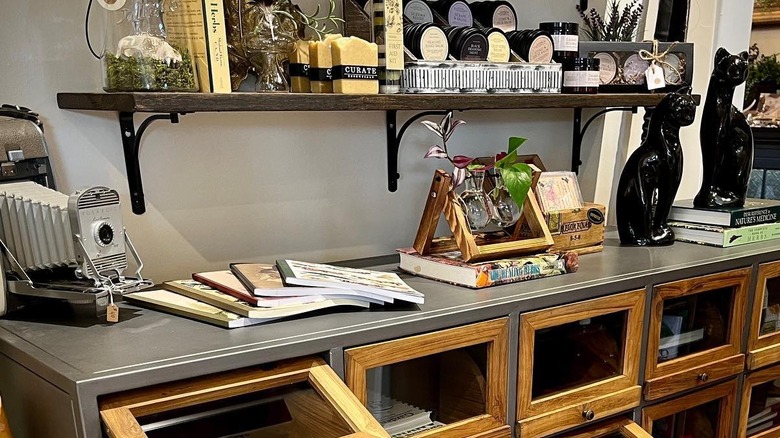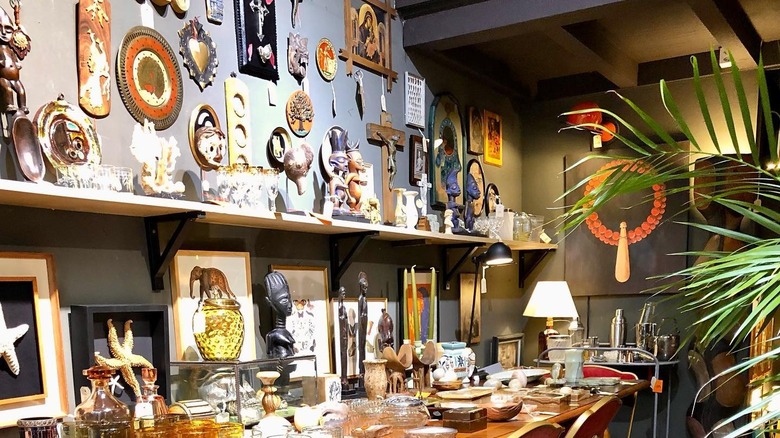An Expert Explains How To Perfectly Style Your Trendy Curiosity Cabinet
Curiosity cabinets have been a unique feature in homes for centuries. According to Sotheby's Institute of Art, the practice began as an aristocratic pastime to entertain guests and solidify one's social standing. The cabinets ranged in size and housed oddities and keepsakes of all types — however, it was the story attached to these items that aristocrats got the most mileage out of when entertaining guests after a feast.
Today, a curiosity cabinet might be an antique treasure chest that utilizes shelves, glass compartments, and more, or a collection of pieces laid out in a more modern arrangement. Regardless of your collection's aesthetic, a unique means to store your keepsakes can be beneficial. "Styling curiosity cabinets is one of my favorite ways to change the feeling and tone of a space, but it also can be one of the trickiest. The beauty of this space in your home is that when given thoughtful consideration, it can be genuinely unique," says Jill Franks, an interior designer with Freemodel, in an exclusive interview with House Digest.
For Franks, what makes this installation special is the personalization that goes into it. "Even if you bought the trendiest cabinet found on every Instagram page, it is the personal selection of pieces for the cabinet that creates transformation and individuality," Franks says.
Build your display strategically
Strategic thinking is a key asset when building out a new display space. Thinking through the location of each piece before setting anything in place can help make the process smoother, and it adds a fun and interactive activity to the display-building process.
"When styling a cabinet, always start with a blank space by removing everything from the shelves. Before you begin, separate your collection of items into large, medium and smaller pieces," says Jill Franks. This organizational step will help clear your head and provide a canvas that will ultimately support a vibrant display area focused on your most precious belongings. However, you may want to avoid placing your favorite pieces on the curiosity cabinet first.
"Build your display by strategically placing your larger pieces on the shelves, then balancing the placement of the items to ensure no one space appears heavier or more weighted than another. Once the larger items are in place, arrange the remaining items, continuing to balance the display. Add height as needed by placing smaller items on a flat surface, or use branches in vases for height," Franks says.
Consider the mood you want to create
Atmosphere and mood are crucial components to any part of your home. The same is true for display cabinets that showcase your favorite decor and collectibles. Utilizing light is a fundamental way to create a desirable home ambiance, so incorporating gentle lighting is likely the way to go if you're showing off something delicate.
"The key to a great curiosity cabinet is to create the mood you desire, from beginning to end, combining the pieces to create your desired style. Add hidden lights to illuminate small spaces or use scones for larger areas," says Jill Franks.
In addition to conscious lighting choices, you may have collected enough pieces to institute a rotation of features in the curiosity cabinet rather than a static display. "Don't be afraid to experiment and change pieces if the look and feel isn't right for you. You might find you do not need or want all the pieces you originally intended to display. Sometimes less is more," explains Franks.
Add personal mementos and art with a story
When styling a curiosity cabinet, it's not enough to showcase items that you think look nice or will add style to your property. To truly personalize and add meaning to the ensemble, you'll want to add a bit of your personality and memories to the mix. "Take time to rummage through storage boxes and old drawers in search of treasured items and mementos that bring back special memories and that make you smile. Revisit old family photos, especially youthful photos of your parents or grandparents, that hold rich sentimental value," says Jill Franks.
Inclusions don't have to be important photos or gifts from cherished loved ones. Instead, they can commemorate trips you've taken, people you've met, or the art that spoke to you at some point in your life. "Consider a sculpture you bought at an antique store, or a basket you bought from a local artisan while away on vacation. I often go to antique stores and curate unusual pieces for clients that generate curiosity, a sense of wonder, or tell a story," Franks says.
Bring in books
Reading materials are a favorite for collectors and those looking to create a thought-provoking curiosity cabinet. Books pull at the heartstrings and bring depth to the imagination. For these reasons and countless others, displaying physical books in a home can serve as a potent mood setter.
"You can stack a couple of books vertically and lay others horizontally with a small treasure displayed atop the covers and spines," says Jill Franks. "You can also show the books' bindings or turn the books so the pages are showing. It really depends on the mood you are trying to create. If you want a different effect, you might remove the cover from one of the books."
Filling your curiosity cabinet with various books or rotating favorite titles from different eras of your life can instill a uniqueness to the space that can't be captured with a focus on other items. You can also pair certain books with mementos that conjure similar feelings.
Don't be afraid to bend the rules
Instead of adhering strictly to the tenets of some famed design theory, it's possible and often advised that homeowners strike out on their own path. Of course, using foundational design rules to help guide you is a good idea, but in the end, whatever makes you happy is the best choice.
"Typically, in design, we are told to group items in threes. Although this works for some spaces, you never want to have every grouping the same. For example, if you are displaying a large vase, stand the vase alone on one side of the shelf. In the middle of the shelf, place three thin candle holders of various heights; on the far side, perhaps add a leaning piece of art and a couple of horizontal books or small plants," explains Jill Franks.
Realistically, the average homeowner's life and assorted collectibles do not feature picture-perfect symmetry. Thankfully, such an ideal is nothing to strive for when styling your curiosity cabinet. "All shelves should not be equal, either. If you use the example above, the shelf below might have two items, or one large bowl, or a basket and set of framed photos," says Franks.
